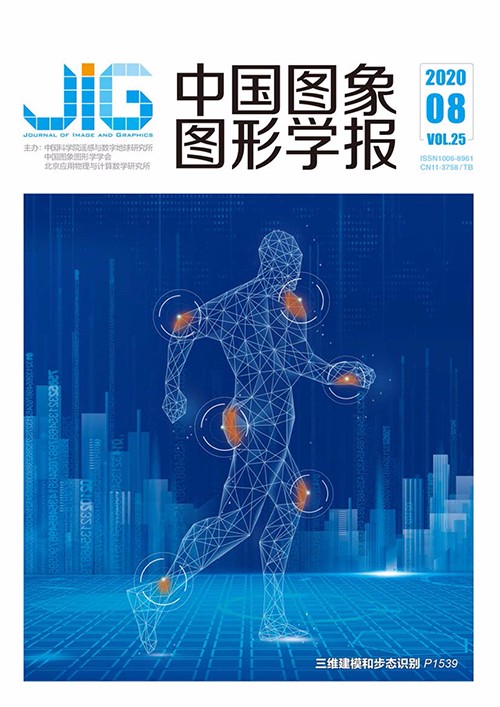
融合注意力机制和高效网络的糖尿病视网膜病变识别与分类
摘 要
目的 糖尿病视网膜病变(diabetic retinopathy,DR)是一种病发率和致盲率都很高的糖尿病并发症。临床中,由于视网膜图像不同等级之间差异性小以及临床医生经验的不同,会出现误诊、漏诊等情况,目前基于人工DR的诊断分类性能差且耗时费力。基于此,本文提出一种融合注意力机制(attention mechanism)和高效率网络(high-efficiency network,EfficientNet)的DR影像自动分类识别方法,以此达到对病变类型的精确诊断。方法 针对实验中DR数据集存在的问题,进行剔除、去噪、扩增和归一化等处理;利用EfficientNet进行特征提取,采用迁移学习的策略用DR的数据集对EfficientNet进行学习与训练,提取深度特征。为了解决病变之间差异小的问题,防止网络对糖尿病视网膜图像的特征学习时出现错分等情况,在EfficientNet输出结果上加入注意力机制;根据网络提取的特征在深度分类器中进行分类,将视网膜图像按等级进行五分类。结果 本文方法的分类精度、敏感性、特异性和二次加权(kappa)值分别为97.2%、95.6%、98.7%和0.84,具有较好的分类性能及鲁棒性。结论 基于融合注意力机制的高效率网络(attention EfficientNet,A-EfficientNet)的DR分类算法有效地提高了DR筛查效率,解决了人工分类的手动提取特征的局限性,在临床上对医生诊断起到了辅助作用,能更有效地防治此类恶性眼疾造成严重视力损伤、甚至失明。
关键词
Automatic recognition and classification of diabetic retinopathy images by combining an attention mechanism and an efficient network
Zhang Zizhen1,2, Liu Ming1,2, Zhu Dejiang1,2(1.College of Electronic and Information Engineering, Hebei University, Baoding 071000, China;2.Key Laboratory of Digital Medical Engineering of Hebei Province, Baoding 071000, China) Abstract
Objective Diabetic retinopathy (DR) is a diabetic complication with high incidence and blindness rate. The diagnosis of DR through color fundus images requires experienced clinicians to identify the presence and significance of many small features. This requirement, along with a complex grading system, makes the diagnosis a difficult and time-consuming task. The small difference among various grades of retinal images and the limited experience of clinicians usually lead to misdiagnosis and missed diagnosis. The large population of diabetic patients and their massive screening requirements have generated interest in a computer-aided and fully automatic diagnosis of DR. The present diagnostic classification of artificial DR is poor, time consuming, and laborious. On this basis, an automatic classification method for DR with a high-efficiency network (EfficientNet) incorporating an attention mechanism (A-EfficientNet) is proposed in this study. The goal of accurate classification is achieved by using the strategy of transfer learning to guide the classification model to learn the features among lesions. Method The characteristics of DR dataset present that noise in images and labels is unavoidable in raw dataset. This condition indicates a high demand for the robustness of our classification system. Preprocessing of retinal images mainly includes retinal image culling, noise reduction, enhancement, and normalization of retinal images. The images after such preprocessing will improve the performance of the classification network, and the computing power of the computer will also be accelerated. We use EfficientNet as the basic network for feature extraction. The migration-learning strategy is adopted to learn and train A-EfficientNet with DR datasets. We design an attention mechanism in EfficientNet to address the problem of small differences among lesions in the dataset and prevent the network from misclassifying fine-grained features in retinal image categories. The mechanism not only can extract features from fundus images but also can focus on the lesion area. The EfficientNet classification model integrated with the attention mechanism(A-EfficientNet) can match images with image label categories to achieve the classification task of retinal images. With fully connected layers and softmax, the model is used to learn for classifying DR status as DRfree, mild DR, moderate DR, severe DR, and proliferative DR. Result Experimental results show that, in the case of insufficient samples of retinal images, the use of transfer learning and data enhancement strategies can help the classification model extract deep features for classification. A-EfficientNet can learn the features in the training samples and pay attention to the differences among various categories of features to achieve accurate classification. The reference to the attention mechanism greatly improves the performance of the classification network. In summary, a high-efficiency network (EfficientNet) incorporating an attention mechanism is proposed in this study. The network plays a positive role in extracting lesion features at various stages of images. The classification accuracy of the model for lesions reaches 97.2%. To improve the classification efficiency, the results of the two-category model indicates sensitivity of 95.6% on the high-specificity operating point and specificity of 98.7% on the high-sensitivity operating point. The result shows that the model achieves a kappa score of 0.840, which is higher than that of the existing non ensemble model. Therefore, the classification model based on the attention mechanism and EfficientNet can accurately distinguish the lesion types of retinopathy. Transfer-learning strategies and data augmentation provide accurate information and assistance for the accurate classification of fundus images. A-EfficientNet reflects the good classification performance of the model and the robustness of the network-learning ability. Conclusion In this study, we use A-EfficientNet to realize automatic classification of retinal images. We also propose a new classification framework for DR, which mainly benefits from four parts, namely, the image-preprocessing stage, the transfer-learning strategy, the introduction of data enhancement, and A-EfficientNet for feature extraction. The dataset used in the experiment has problems, such as noise, artifacts, and unsuccessful focusing. After such problematic data are removed, the dataset is denoised and normalized to facilitate the classification network for calculating and learning the data. When the training samples are insufficient, the introduction of data enhancement meets the data requirements of the deep learning classification model, satisfies the model's learning of the data, and improves the generalization ability of the model. The introduction of an attention mechanism based on EfficientNet can improve the classification performance of the algorithm. Therefore, the automatic classification algorithm for DR incorporating the attention mechanism of EfficientNet can effectively improve the efficiency of DR screening, avoid the limitations of artificial feature extraction and image classification, and solve the problem of over fitting caused by insufficient sample data. The experimental results show that this method can be used to diagnose DR. It can operate efficiently without marking the information of suspicious lesions and thus avoids the time-consuming work of labeling lesions by experts and reduces false positives. The classification model can also be referenced in the classification tasks of other images.
Keywords
mutil-classification of diabetic retinopathy high-efficiency network (EfficientNet) attention mechanism deep learning transfer learning deep features
|



 中国图象图形学报 │ 京ICP备05080539号-4 │ 本系统由
中国图象图形学报 │ 京ICP备05080539号-4 │ 本系统由